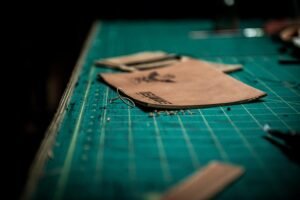Exploring the Ethical Landscape of Alligator Leather Harvesting
Imagine strolling through a bustling city, the sun casting a warm glow on the pavement, as you casually glance through the shop windows. Suddenly, your eyes are drawn to a luxurious leather handbag on display, its rich texture and exquisite design catching your attention. But as you admire its craftsmanship, have you ever wondered about the ethical implications behind the production of alligator leather? In this thought-provoking article, we will take a closer look at the ethical landscape of alligator leather harvesting, unraveling the intricate web of considerations surrounding this controversial industry. From the conservation efforts to the treatment of these majestic creatures, get ready to explore an often-overlooked dimension of consumer choices that lies beneath the glamorous surface.
Methods of Alligator Leather Harvesting
Trapping and Hunting
Trapping and hunting are the traditional methods used for harvesting alligator leather. Trappers set up baited traps along the waterways or in marshy areas where alligators are known to inhabit. Once trapped, the alligators are killed for their leather. Hunting, on the other hand, involves pursuing alligators and shooting them. Both methods, when conducted responsibly and within legal frameworks, can maintain sustainable populations while providing a source of income for communities.
Ranching
Ranching is another popular method of alligator leather harvesting. It involves the breeding and raising of alligators on specialized farms. These farms provide a controlled environment where alligators can be harvested for their leather without negatively impacting wild populations. Ranching ensures a consistent supply of alligator leather and reduces the pressure on natural habitats. This method also allows for the tracking and monitoring of individual alligators, which can aid in conservation efforts.
Environmental Impact
Habitat Disruption
Alligator leather harvesting, particularly through trapping and hunting, can lead to habitat disruption. The activities associated with harvesting may damage the natural habitats of alligators and other species that rely on these ecosystems. Trappers and hunters may inadvertently disturb nesting sites, destroy vegetation, or alter the water quality within these habitats. It is crucial to implement sustainable practices that minimize habitat disruption to ensure the long-term survival of alligator populations and maintain healthy ecosystems.
Species Conservation
Despite potential habitat disruption, alligator leather harvesting can support species conservation efforts. Trappers, hunters, and ranchers work closely with conservation organizations to protect and preserve alligator populations. Sustainable harvesting practices, strict quotas, and monitoring programs help prevent overexploitation and ensure the sustainability of alligator populations. By generating revenue and fostering collaboration between stakeholders, the alligator leather industry becomes an important driver for conservation initiatives.
Water Pollution
Water pollution is a concern associated with alligator leather harvesting, particularly in areas where chemicals are used for tanning and preserving the leather. Unregulated or irresponsible disposal of these chemicals can have detrimental effects on water quality and aquatic ecosystems. Strict regulations and enforcement measures are necessary to ensure that the industry minimizes its impact on water sources. Implementing responsible waste management practices and promoting eco-friendly alternatives in the tanning process can further mitigate water pollution risks.

This image is property of images.pexels.com.
Regulations and Legal Frameworks
CITES
The Convention on International Trade in Endangered Species of Wild Fauna and Flora (CITES) plays a crucial role in regulating the international trade of alligator leather. By listing certain alligator species under CITES Appendix I or II, the trade of their leather is strictly controlled. CITES permits and monitors the harvest and trade of alligator leather, ensuring its legality and sustainability. This international framework promotes collaboration between countries and supports conservation efforts on a global scale.
State Laws
In addition to international regulations, individual states within countries like the United States have implemented their own laws to protect alligator populations and regulate the leather industry. These state laws establish quotas, harvesting seasons, and licensing requirements for alligator leather harvesting activities. They also provide a legal framework to address any violations and enforce penalties on those who contravene the regulations. State laws serve as an essential tool in balancing the economic benefits of alligator leather with the conservation of these iconic species.
Enforcement
Enforcement of regulations and legal frameworks is crucial to ensure compliance and prevent illegal practices within the alligator leather industry. Governments, wildlife enforcement agencies, and conservation organizations collaborate to monitor the activities of trappers, hunters, and ranchers. Regular inspections, audits, and investigations help identify and address any violations or breaches of regulations. Strong enforcement deters illegal activities, protects alligator populations, and maintains the integrity of the alligator leather industry.
Working Conditions and Community Impact
Labor Standards
Ensuring fair and safe working conditions for those involved in alligator leather harvesting is essential. Employers, whether they are trappers, hunters, or ranchers, must comply with labor laws and standards. These include fair wages, reasonable working hours, workplace safety, and access to healthcare. All workers involved in the industry should be treated with respect and have the opportunity to voice any concerns or grievances. Upholding labor standards promotes a sustainable and ethical alligator leather industry.
Local Employment
The alligator leather industry often provides employment opportunities, particularly in rural and coastal communities where alligators are prevalent. Local residents can find employment as trappers, hunters, farm workers, or in other related roles. This industry helps create economic stability in these communities and reduces the need for people to leave in search of employment opportunities elsewhere. By supporting local employment, the alligator leather industry contributes to the socio-economic development of these regions.
Community Relationships
Building positive relationships with local communities is vital for the sustainable development of the alligator leather industry. Companies and individuals involved in alligator leather harvesting should engage with community members, respect their cultural values, and involve them in decision-making processes. Collaborative partnerships can be formed to address concerns and ensure that the industry benefits both the community and the environment. By fostering strong community relationships, the alligator leather industry can thrive while maintaining social responsibility.

This image is property of images.pexels.com.
Alternatives to Alligator Leather
Synthetic Materials
With advancements in technology, synthetic materials have emerged as viable alternatives to alligator leather. These materials can closely mimic the texture and appearance of genuine alligator leather, offering consumers a cruelty-free option. Synthetic materials are also more environmentally friendly, as they do not require the harvesting of alligators or the use of chemicals in the tanning process. Their availability and affordability make them an attractive choice for consumers who prioritize animal welfare and sustainability.
Plant-based Alternatives
Plant-based alternatives to alligator leather are also becoming increasingly popular. Innovative materials made from pineapple leaves, mushroom fibers, or plant-based polymers offer a sustainable and cruelty-free option for those seeking an alternative to animal leather. These materials not only reduce the demand for alligator leather but also promote the use of renewable resources. By exploring and investing in plant-based alternatives, the fashion industry can encourage a shift towards more ethical and environmentally conscious practices.
Consumer Awareness and Responsibility
Supply Chain Transparency
Consumer awareness plays a crucial role in influencing the practices of the alligator leather industry. Transparent supply chains allow consumers to make informed choices about the products they purchase. Responsible companies should provide detailed information about the sourcing and production of their alligator leather products, ensuring transparency at every stage. By demanding transparency and supporting brands that prioritize ethical practices, consumers can drive positive change within the industry.
Certifications and Labels
Certifications and labels offer consumers a way to identify products that meet specific ethical standards. Various organizations provide certifications that ensure responsible sourcing, fair labor practices, and environmental sustainability. For alligator leather products, certifications such as the Leather Working Group certification or the Global Organic Textile Standard label can indicate a commitment to ethical and sustainable practices. Being aware of these certifications and labels empowers consumers to make conscious choices that align with their values.

This image is property of images.pexels.com.
Ethical Considerations and Cultural Perspectives
Indigenous Practices
For many indigenous communities, alligator leather harvesting has deep cultural and historical significance. It is essential to respect and preserve these practices while ensuring their sustainability. By engaging with indigenous communities, their knowledge and traditions can be integrated into sustainable harvesting methods. Collaboration and mutual respect between all stakeholders can help balance cultural perspectives with ethical considerations, leading to a more inclusive and respectful alligator leather industry.
Historical Significance
Alligator leather harvesting is often deeply rooted in the history and heritage of certain regions. It has contributed to the economic development and cultural identity of these areas. Acknowledging and understanding the historical significance of alligator leather can help foster appreciation for the craft and its cultural value. While ethical considerations are paramount, recognizing the cultural significance of alligator leather can contribute to a more comprehensive understanding of its place in our society.
Benefits and Economic Importance
Revenue Generation
The alligator leather industry generates significant revenue, contributing to local, regional, and national economies. The sale of alligator leather products can generate income for individual trappers, hunters, ranchers, as well as the companies involved in processing and retail. Additionally, tourism related to alligator sightings and alligator leather products can boost local economies. This revenue provides economic stability, supports businesses, and creates opportunities for community growth and development.
Industry Support
The alligator leather industry plays a vital role in supporting related businesses and industries. Leather processing facilities, fashion designers, retailers, and artisans all rely on the supply of alligator leather. The industry’s demand creates business opportunities and fosters economic growth. By supporting the industry, these businesses indirectly contribute to job creation, innovation, and the overall prosperity of the communities involved.
Conservation Efforts
Contrary to popular belief, the alligator leather industry can actively contribute to conservation efforts. The revenue generated from the industry can be directed towards habitat restoration, research programs, and wildlife conservation initiatives. By partnering with conservation organizations, the industry can actively participate in the conservation and protection of alligator populations and their ecosystems. This collaborative approach ensures that the economic benefits of alligator leather harvesting are channeled back into preserving these iconic species.
Collaborative Approaches and Initiatives
Sustainable Farming Practices
Ranching can be further improved through the implementation of sustainable farming practices. By prioritizing the welfare and habitat needs of alligators, ranchers can contribute to the long-term conservation of these species. Practices such as minimizing stress, providing appropriate nutrition, and ensuring adequate living space can enhance the well-being of captive alligators. Sustainable ranching practices, when combined with rigorous monitoring and research, allow for continuous improvement and contribute to the overall sustainability of the alligator leather industry.
Educational Programs
Educational programs play a crucial role in raising awareness and improving practices within the alligator leather industry. Trappers, hunters, ranchers, and other stakeholders can benefit from training programs that promote ethical and sustainable practices. These programs can provide knowledge about species conservation, habitat preservation, and wildlife management. By investing in education, the industry can foster a culture of sustainability and empower individuals to make responsible decisions within their respective roles.
Research and Development
Continuous research and development efforts can lead to innovative solutions and practices within the alligator leather industry. Collaborative research projects can focus on sustainable tanning methods, habitat rehabilitation, and genetic studies to enhance breeding programs. By embracing scientific advancements, the industry can adapt and improve its practices, ensuring a sustainable and ethical future. Research and development initiatives foster innovation, attract investment, and contribute to the industry’s evolution.
Conclusion
Exploring the ethical landscape of alligator leather harvesting reveals the complex interplay between conservation, cultural significance, and economic importance. By implementing responsible harvesting methods, supporting sustainable ranching practices, and promoting alternatives, the alligator leather industry can strike a balance that respects animal welfare, protects ecosystems, and benefits local communities. Consumer awareness, collaboration, and ongoing research are essential in ensuring a more ethical and sustainable future for the industry. With a collective effort, we can create a world in which the allure of alligator leather can coexist with our responsibility to preserve and protect these remarkable creatures for generations to come.



